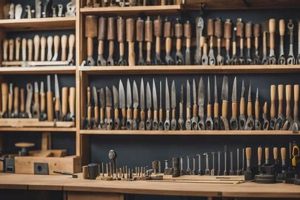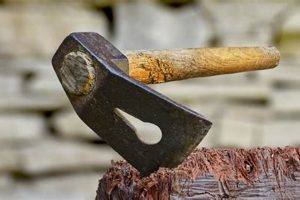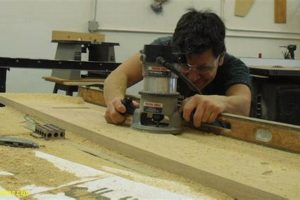Essential implements utilized in shaping and manipulating wood are fundamental to the craft. This category encompasses a diverse range of instruments, from hand-operated devices like saws and planes to power-driven machinery such as drills and sanders. A handsaw, for example, allows for controlled, precise cuts, while a power drill facilitates efficient hole creation for joinery.
Proficiency in woodworking relies heavily on the effective employment of these implements. Their proper selection and skillful application directly impact the quality, precision, and efficiency of woodworking projects. Historically, the development of more sophisticated tools has broadened the possibilities within woodworking, allowing for intricate designs and enhanced productivity. The selection of appropriate instruments contributes significantly to achieving desired outcomes and minimizing potential errors.
A subsequent examination will categorize these essential items into specific groupings based on their primary functions, including cutting, shaping, joining, and finishing. This detailed exploration will provide insight into the variety of available options and their applications within different woodworking contexts.
Essential Usage Guidelines
The following guidelines are designed to optimize the use and longevity of implements used to shape and form wood. Adherence to these recommendations can improve project outcomes and promote safety.
Tip 1: Tool Maintenance: Consistent cleaning and sharpening are vital. Remove debris after each use and hone cutting edges regularly. A dull blade necessitates more force, increasing the risk of accidents and compromising cut quality.
Tip 2: Proper Storage: Store implements in a dry, organized environment. This prevents rust, damage, and loss. Utilize dedicated toolboxes or racks to maintain order and accessibility.
Tip 3: Safety Equipment: Always wear appropriate protective gear, including safety glasses, hearing protection, and dust masks. These precautions minimize the risk of injury from flying debris, loud noises, and harmful dust particles.
Tip 4: Correct Tool Selection: Choosing the right implement for a task is crucial. Using a tool designed for a specific purpose ensures greater efficiency, accuracy, and safety. Attempting to force a tool to perform beyond its capabilities can lead to damage or injury.
Tip 5: Secure Workpiece: Before commencing any cutting or shaping operation, securely clamp or hold the workpiece in place. Movement during the process can result in inaccurate cuts and potential hazards.
Tip 6: Gradual Material Removal: When using power tools, remove material in small increments. This technique provides greater control, reduces the risk of kickback, and prevents overheating of the tool or workpiece.
Tip 7: Follow Manufacturer Instructions: Always consult and adhere to the manufacturer’s instructions for each specific tool. These guidelines provide crucial information on safe operation, maintenance, and troubleshooting.
Following these guidelines contributes to the prolonged utility and safe application of implements used for woodworking, ultimately leading to superior craftsmanship and reduced risk of accidents.
The subsequent section will elaborate on specific tool categories and their specialized applications within various woodworking techniques.
1. Cutting
The process of severing or dividing wood, termed “cutting,” is a foundational element of woodworking, directly necessitating a specific subset of implements. The effectiveness and precision of the cut directly impact the overall quality and structural integrity of the final product. Incorrect cutting techniques, or the use of inappropriate implements, can result in material waste, inaccurate dimensions, and compromised joint strength. For example, employing a dull saw blade can lead to splintering and tear-out, requiring additional time and material to correct the defect. Conversely, a sharp, properly selected saw, guided with precision, yields clean, accurate cuts that minimize subsequent processing.
Several implements are commonly employed to achieve various cutting outcomes. Handsaws, including backsaws and crosscut saws, offer control and precision, particularly useful for intricate joinery and delicate work. Power saws, such as circular saws, table saws, and bandsaws, provide increased efficiency for larger stock removal and repetitive cuts. Chisels, both hand-held and powered, are crucial for precise material removal in specific areas, often used for shaping joints or creating decorative details. The selection of the appropriate cutting implement is dependent upon factors such as the wood species, the cut type, the desired level of precision, and the scale of the project.
In conclusion, the relationship between “cutting” and woodworking implements is intrinsic. Efficient and accurate material division is paramount to the successful execution of any woodworking endeavor. Understanding the characteristics and applications of diverse cutting instruments is essential for achieving desired outcomes, minimizing waste, and ensuring structural integrity. The skillfull application of these implements, combined with appropriate safety measures, defines the competence of the woodworker and the quality of the resulting work.
2. Shaping
The process of shaping within woodworking transforms raw material into refined forms. This transformative phase relies heavily on a specific set of implements designed to remove, contour, and refine the wood’s surface. The accuracy and control exhibited during shaping directly influence the aesthetic appeal and functional performance of the finished piece.
- Planes: Surface Refinement
Planes, encompassing block planes, smoothing planes, and jack planes, are essential for achieving flat, even surfaces and precise angles. A smoothing plane, for instance, removes imperfections left by coarser tools, creating a surface ready for finishing. The correct selection and adjustment of a plane dictates the quality of the finished surface, thereby influencing the project’s overall aesthetic.
- Rasps and Files: Controlled Material Removal
Rasps and files allow for the controlled removal of material, particularly useful for shaping curved surfaces and refining intricate details. A cabinet rasp, with its coarse teeth, rapidly removes stock, while a finer file smooths out imperfections. The effective use of these tools requires a delicate touch and an understanding of wood grain to prevent tear-out.
- Spokeshaves: Curved Surface Definition
Spokeshaves are specifically designed for shaping curved surfaces, such as chair spindles or boat components. Their adjustable blades allow for precise material removal along convex and concave forms. Proper technique involves consistent blade angle and controlled pressure to achieve smooth, flowing curves.
- Power Sanders: Accelerated Surface Preparation
Power sanders, including random orbital and belt sanders, accelerate the surface preparation process. While offering efficiency, they demand careful control to avoid over-sanding and altering the intended shape. Different grit levels are employed to progressively refine the surface, preparing it for finishing applications.
These implements, essential to the shaping process, necessitate both skill and understanding for effective application. The correct selection and precise manipulation of these implements transform raw wood into intricate forms and refined surfaces, highlighting the intrinsic connection between “shaping” and the fundamental practices of woodworking.
3. Measuring
Accurate dimensioning, facilitated by appropriate implements, is a critical determinant of success in woodworking. Precise measurement directly impacts the fit and functionality of joined components. Deviations from specified dimensions, even seemingly minor discrepancies, can compound during assembly, resulting in structural instability, misalignment of elements, and a diminished aesthetic quality. For instance, if the mortise and tenon of a joint are not measured and cut accurately, the resulting connection may be weak, requiring remedial action and compromising the longevity of the piece. Consistent and reliable measurement practices are thus essential, not merely preferential, within the woodworking process.
Several implements are indispensable for achieving precision in dimensional control. Rulers and measuring tapes provide linear measurements, essential for determining stock size and overall project dimensions. Squares ensure orthogonality, verifying that corners are 90 degrees, which is vital for stable and visually appealing construction. Levels and plumb bobs guarantee that vertical and horizontal elements are aligned correctly, preventing imbalances and ensuring structural integrity. Calipers provide precise internal and external measurements, allowing for accurate joinery and fitting of small components. Furthermore, marking gauges are used to scribe parallel lines, crucial for repeatable tasks and consistent material removal during shaping. The skillful and informed selection of these instruments is vital for maintaining accuracy throughout the woodworking process. A table leg measured off by even 1/16th inch can throw off the whole dimension of a woodworking project.
In conclusion, accurate dimensioning is inextricably linked to successful woodworking outcomes. Precise employment of measuring devices mitigates errors, ensures structural soundness, and contributes significantly to the overall aesthetic of finished products. Disregard for accurate measurement inevitably leads to material waste, time-consuming rework, and diminished project quality. Therefore, proficiency in measurement techniques and diligent use of appropriate instruments represent a core competency for effective woodworking practice.
4. Fastening
The process of joining separate wooden components, termed “fastening,” is integral to woodworking, demanding a specific selection of implements for secure and stable assembly. The method of fastening directly impacts the structural integrity, longevity, and aesthetic presentation of a finished piece. Inadequate fastening can lead to structural failure, material separation, and a compromised overall result. For instance, poorly driven nails in a frame can result in joint weakness, leading to racking and eventual failure of the structure. Conversely, proper fastening techniques, employing the correct tools, contribute to the strength and durability of the completed project.
A variety of implements are essential for effective fastening. Hammers and mallets drive nails and wedges, providing a mechanical bond between components. Screwdrivers and drills insert screws, offering a more secure and adjustable connection. Clamps apply pressure during adhesive bonding, ensuring tight joints during the curing process. Furthermore, specialized tools such as biscuit jointers and doweling jigs facilitate precise alignment and reinforcement of joints. The selection of the correct fastening method and the corresponding implement depends on the wood species, joint design, load requirements, and desired aesthetic. For example, fine furniture construction often employs dovetail joints reinforced with adhesive, requiring precise clamping during assembly, whereas rough carpentry may rely on nailed joints for speed and efficiency.
In summary, the process of fastening is inextricably linked to the successful execution of woodworking projects. Appropriate selection and skillful application of tools designed for joining ensures structural stability, enhances aesthetic appeal, and contributes to the overall durability of the completed work. Neglecting proper fastening techniques and the utilization of appropriate implements can result in diminished project quality and premature failure. Competency in fastening techniques and the utilization of appropriate tools represents a fundamental skill for any proficient woodworker, playing a critical role in both structural integrity and artistic expression.
5. Finishing
The process of surface treatment, known as “finishing”, represents the concluding stage in woodworking, inextricably linked to the implements utilized throughout the entire construction process. The quality and durability of the final finish are influenced not only by the finishing materials themselves but also by the preparation facilitated by various tools.
- Sanders: Surface Preparation
Achieving a smooth, even surface is paramount prior to applying any finish. Sanders, including orbital, belt, and detail sanders, play a pivotal role in removing imperfections, scratches, and milling marks. The selection of appropriate grit sandpaper and the application of consistent sanding techniques directly influence the adhesion and appearance of the finish. Inadequate sanding results in a finish that highlights imperfections, while proper sanding creates a uniform substrate for optimal results.
- Sprayers: Application of Coatings
Sprayers, encompassing airless and HVLP (High Volume Low Pressure) systems, offer a means of applying finishes uniformly and efficiently. These tools are utilized for applying paints, varnishes, lacquers, and stains, enabling the creation of consistent coverage and minimizing brush strokes. The proper selection of a sprayer nozzle, coupled with appropriate viscosity adjustment of the finishing material, directly impacts the final appearance and protective qualities of the applied coating.
- Brushes and Applicators: Targeted Coating Application
Brushes, rollers, and specialized applicators are employed for targeted application of finishes, particularly in intricate areas or when precise control is required. Brush selection, bristle type, and application technique influence the texture and uniformity of the applied finish. Inadequate brush control can result in drips, runs, and uneven coverage, while proper brushwork ensures a smooth and consistent surface.
- Polishing Compounds and Buffing Wheels: Surface Enhancement
Polishing compounds and buffing wheels are employed to enhance the sheen and smoothness of the finished surface. These tools are used to remove minor imperfections, level the finish, and create a high-gloss appearance. The selection of appropriate polishing compounds and buffing pads, coupled with controlled buffing pressure, is essential for achieving the desired level of gloss without damaging the underlying finish.
In conclusion, the application of appropriate finishing techniques and the selection of compatible implements directly contribute to the aesthetic appeal and protective properties of woodworking projects. Surface preparation through sanding, coating application via sprayers or brushes, and final enhancement through polishing represent interconnected steps in the finishing process, each relying on specific tools to achieve optimal results. Thus, knowledge of finishing techniques and competence in the use of these implements constitute essential skills for woodworking.
6. Maintenance
The longevity and optimal performance of implements used for woodworking are intrinsically linked to consistent maintenance practices. Diligent care ensures that these essential instruments function as designed, contributing to accuracy, efficiency, and safety throughout the woodworking process. Neglecting routine maintenance shortens the lifespan of implements, increases the risk of malfunction, and ultimately diminishes the quality of workmanship.
- Sharpening of Cutting Edges
Cutting implements, such as saws, chisels, and planes, require periodic sharpening to maintain their effectiveness. A dull edge necessitates increased force, leading to imprecise cuts, material damage, and elevated risk of injury. Sharpening stones, honing steels, and specialized sharpening jigs are essential tools for this maintenance. For instance, a dull plane iron creates a rough surface, requiring additional sanding and compromising the intended finish. Regular sharpening ensures clean cuts and efficient material removal.
- Cleaning and Lubrication
Removal of debris, such as sawdust and resin, is crucial for preventing corrosion and maintaining smooth operation. Brushes, cloths, and solvents are utilized for cleaning. Lubrication of moving parts, such as bearings and threads, reduces friction, prevents wear, and ensures optimal performance. Neglecting lubrication in a power drill, for example, can lead to overheating and premature motor failure. Regular cleaning and lubrication extend the tool’s lifespan and prevent operational problems.
- Rust Prevention
Exposure to moisture can lead to rust formation on metallic implements, compromising their structural integrity and performance. Application of rust inhibitors, such as oils or protective coatings, is essential for preventing corrosion. Proper storage in a dry environment also minimizes the risk of rust. For instance, a rusty saw blade loses its cutting efficiency and may require replacement. Consistent rust prevention measures preserve the tool’s condition and functionality.
- Inspection and Repair
Regular inspection for damage, such as cracks, loose handles, or worn components, is vital for identifying potential safety hazards and performance issues. Timely repair or replacement of damaged parts prevents further deterioration and ensures safe operation. For example, a loose hammerhead poses a significant safety risk and requires immediate attention. Regular inspection and prompt repair maintain the tool’s safety and effectiveness.
These maintenance facets underscore the fundamental connection between implement care and successful woodworking. Consistent application of these practices prolongs the lifespan of implements, enhances their performance, and contributes to a safer and more productive woodworking environment. Neglecting maintenance ultimately leads to diminished tool functionality, increased risk of accidents, and compromised project quality, emphasizing the importance of proactive implement care within woodworking practice.
Frequently Asked Questions
This section addresses common inquiries regarding implements used in woodworking, providing clarity on their selection, maintenance, and proper application.
Question 1: What constitutes the essential set of implements for a beginning woodworker?
A foundational kit typically includes a combination square, measuring tape, hand saw, block plane, set of chisels, a mallet, and assorted sandpaper. This collection enables basic cutting, shaping, and joining operations.
Question 2: How frequently should implements with cutting edges be sharpened?
Sharpening frequency depends on usage and the material being worked. As a general guideline, edges should be honed before each project and professionally sharpened when they lose their keenness. Dull edges increase the risk of accidents and reduce cut quality.
Question 3: What safety precautions should be observed when operating power implements?
Eye protection, hearing protection, and dust masks are essential. Workpieces must be securely clamped, and tools operated according to the manufacturer’s instructions. Avoid loose clothing or jewelry that could become entangled in moving parts.
Question 4: How does one determine the appropriate implement for a specific woodworking task?
Selection is based on the task’s nature, wood species, desired precision, and the operator’s skill level. Consultation with woodworking guides and experienced practitioners can aid in informed decision-making.
Question 5: What are the key differences between hand-operated and power-driven implements?
Hand implements offer greater control and precision, suitable for intricate work. Power implements provide increased efficiency and speed for larger projects and repetitive tasks. Each category has specific advantages and disadvantages.
Question 6: What storage practices prolong the life and maintain the functionality of woodworking implements?
Implements should be stored in a dry, organized environment to prevent rust and damage. Cutting edges should be protected with guards or sheaths. Regular cleaning and lubrication further contribute to their preservation.
Proficiency in the selection and usage of implements is cultivated through dedicated practice and a commitment to safety. Prioritize continuous skill development to refine woodworking expertise.
The subsequent section explores advanced techniques and specialized implements used in specific woodworking disciplines.
Conclusion
This exploration has emphasized the fundamental role of implements in shaping and manipulating wood. The proper selection, skilled application, and diligent maintenance of implements are crucial for achieving precise, durable, and aesthetically pleasing results. From basic cutting and shaping to intricate joinery and fine finishing, implements function as extensions of the woodworker’s skill and intention.
Continued advancement in the craft hinges upon a sustained commitment to understanding and utilizing implements effectively. The pursuit of knowledge and refinement of technique remains essential for those seeking to transform raw material into enduring creations. The legacy of woodworking is built upon a foundation of skillful practice and respect for the instruments that enable its enduring expression.







